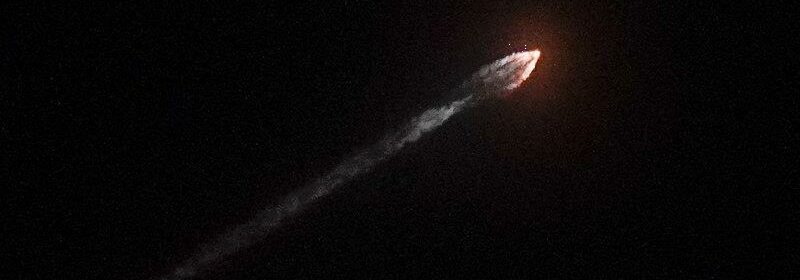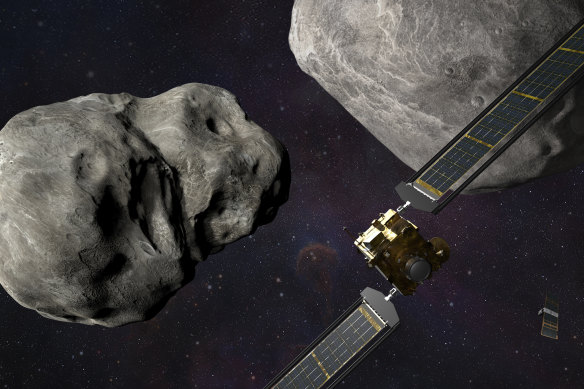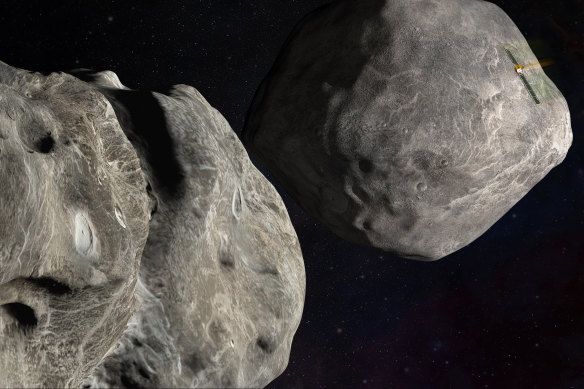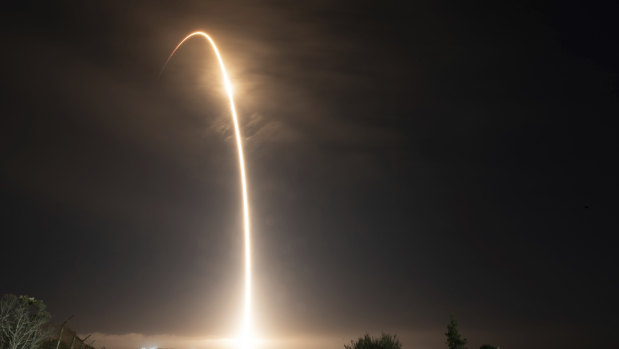Planetary defence: How to watch NASA’s attempt to intercept an asteroid

An asteroid minding its own business not too far from Earth is about to get knocked about by a visitor from our planet.
On Tuesday morning AEST, NASA’s Double Asteroid Redirection Test spacecraft, or DART, is set to collide with Dimorphos, a small asteroid that is the moon of a larger space rock, Didymos.
Artist’s rendering of NASA’s DART probe, foreground right, and Italian Space Agency’s LICIACube, bottom right, at the Didymos system before impact with the asteroid Dimorphos, left.Credit:AP
While these two near-Earth objects pose no immediate threat to our world, NASA launched DART last year to test a technique that could one day be used for planetary defence. Here’s what you need to know about the mission.
When is the collision, and how can I watch it?
DART is set to crash into Dimorphos at 14,000 mph (22,000 km/h) at 7.14pm on Monday Florida-time. (9.14am AEST on Tuesday)
The targets the asteroid Dimorphos, left, which orbits Didymos. Credit:AP
NASA Television will broadcast coverage of the end of this mission beginning at 8am AEST .
If all you want to watch is a stream of photos from the spacecraft as it closes in on the asteroid, NASA’s media channel will begin broadcasting those at 7.30 am, Florida-time.
Why is NASA crashing into an asteroid?
NASA isn’t just wasting an expensive, sophisticated spacecraft for fun. The agency is doing its job.
In 2005, Congress set a mandate for NASA to find, by 2020, 90 per cent of near-Earth asteroids that are big enough to destroy a city — those that are 140 metres or wider in diameter. But Congress never gave NASA much money to perform that task, so it remains more than half unfinished, with about 15,000 more of such asteroids to discover.
The SpaceX Falcon 9 rocket launches with the Double Asteroid Redirection Test, or DART, spacecraft onboard in November of 2021, from Vandenberg Space Force Base in California.Credit:AP
While the agency is searching the heavens for deadly space rocks, it also is developing methods for responding to a threat, should one emerge.
The DART mission isn’t like the movie Armageddon. Blowing up an asteroid generally would not be a good thing to do. Rather, the mission is a proof-of-principle demonstration that hitting an oncoming asteroid with a projectile can nudge it into a different orbit.
For a dangerous oncoming asteroid, that nudge could be enough to change the trajectory from a direct hit to a near miss.
What will happen during the collision?
The mission’s target is Dimorphos, a small asteroid that is about 500 feet (152 metres) in diameter and orbits a larger object, a nearly one kilometre-wide asteroid named Didymos. A distance of about one kilometre separates the two, with Dimorphos completing one orbit around Didymos every 11 hours, 55 minutes.
DART will essentially be a self-driving suicidal spacecraft, guiding itself to its demise with people at the mission operations center at the Johns Hopkins Applied Physics Laboratory in Maryland largely just spectators.
“You’re moving extremely fast,” said Elena Adams, the DART mission systems engineer. “And at that point, you cannot really send any commands. And so your system has to be very, very precise in how it’s controlling the spacecraft.”
DART’s camera will not spot Dimorphos as a separate dot from Didymos until about an hour before the crash. Then it will adjust its flight path, ending in a glorious collision.
“It is really hard to hit a very little object in space, and we’re going to do it,” Adams said.
What happens if the mission succeeds?
If DART and Dimorphos connect as planned, the small asteroid’s orbit will get closer to the larger Didymos. The magnitude of the change will depend on the structure and composition of Dimorphos.
If Dimorphos is solid and DART carves only a small crater, then the change will follow the basics of a Physics 101 problem — two objects colliding and sticking together. Because DART is moving in the direction opposite to Dimorphos, it will sap some of the asteroid’s angular momentum, causing it to move closer to Didymos and speed up.
But if Dimorphos is more like a pile of rubble held together by gravity, then the impact will create a deep crater and send a shower of debris flying into space. That cascade of rock will be like the thrust of a rocket engine pushing against the asteroid. In that case, the orbit of Dimorphos will descend even closer to Didymos.
This article originally appeared in The New York Times.
Most Viewed in World
From our partners
Source: Read Full Article


